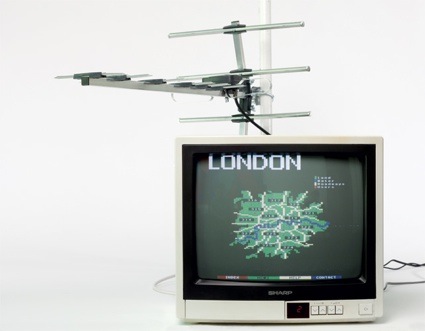 Social Teletext Network
Social Teletext Network
During the Arab Spring in Tunisia, Egypt, and Libya, governments restricted the access to the Internet in an effort to hamper online peer networking and thus self-organization. Could other governments ever operate a similar media shutdown and cut their citizens off the internet?
What would we do if ever an Internet kill switch was implemented in our country? Not necessarily to prevent us from orchestrating riots but to protect the internet “from unspecified assailants”.
At the latest graduation show of the Design Interactions department in London, Philipp Ronnenberg was showing 3 methods to prepare for the time after a cyberwar. The Post Cyberwar Series proposes an alternative open navigation system, a makeshift wireless communication infrastructure as well as a novel data storage.
The Teletext Social Network enables people to bypass network providers and governmental institutions and communicate using the analogue television broadcasting which was freed last April in the UK.
OpenPositioningSystem relies on the seismic activity, produced by generators in power plants, turbines in pumping stations or other large machines running in factories to provide an open navigation system. I interviewed the designer about it a few months ago.
Finally, Sewer Cloud is a bit more complex. The system is inspired by the current research on the storage of data into DNA. 1 gram of DNA is capable of storing up to 700 terabytes of data.
People living in urban areas could use the Sewer Cloud as a living, self-reproducing data network. This living network would be located in the sewerage system and use the algae species Anabaena bacteria for the insertion and extraction of data.
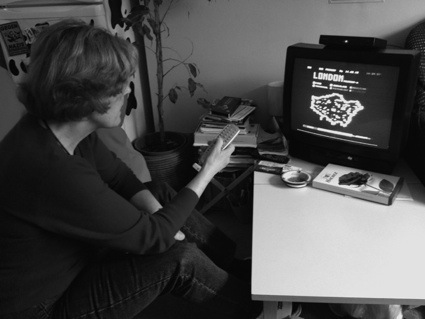 Member using the Social Teletext Network
Member using the Social Teletext Network
I contacted Philipp again to ask for more details about his project:
Hi Philipp! When i first interviewed you about the OPS, you didn’t mention the kill switch. How did it go from one project about positioning system to a more complex scenario in which internet has been killed off? Were you inspired by any particular events from the recent news? I’m thinking of the NSA data collection: isn’t controlling the internet and surveilling our every click enough for States?
The kill switch scenario stands for “killing” the Internet. But the Internet is only one network which is under control of companies and governmental institutions. The kill switch particularly is about the Internet, but other networks such as GPS navigation and mobile phone networks can be affected as well. In all three cases, the GPS navigation network, the mobile phone networks and the Internet, the control is in the hand of companies and governmental institutions.
I wanted to create three independent network alternatives. The body of work wrapped in the series Post Cyberwar is a reflection of how dependent we are today on the authoritarian structures of the networks we are using day to day. It is not only about surveillance and tracking down activity of users, it is also about content which becomes increasingly restricted, censored and monitored. The installation of controlling instances (i.e. kill switch) within these networks is justified with cyberwar and cyber-terrorism.
The recent news of the NSA data collection came just about right for the project. I have been working on the Post Cyberwar series since we last met. For me, it was always obvious that the NSA or any other governmental institutions are monitoring, but I was surprised about the dimension. Nowadays the perception (in the public) of surveillance has slightly changed, thanks to the main stream media and whistleblowers like Snowden. When I talked 5 years ago about surveillance and tracking, I often heard words like paranoid and being mistrustful.
Controlling the Internet and surveilling our every click is enough for getting an insight. But as we saw in Georgia, Egypt and sometimes China, shutting down the Internet and mobile phone networks (or at least parts of it), is a powerful way to prevent communication and the circulation of undesirable information.
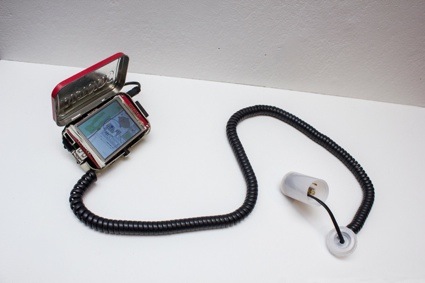 OpenPositioningSystem. Sensor prototype
OpenPositioningSystem. Sensor prototype
OpenPositioningSystem
Speaking of OPS, how much has it grown since we last talked about it? Have the prototype and software improved and has the project given rise to attention and interest?
The OPS has grown a lot. First it got attention through your first blogpost and it was reblogged by some bigger blogs. I got very diverse feedback from “this comes out when art students try to be engineers (theverge.com comments)” and people asking me to get actively involved. I have 80 registered members on the website so far, but there is not much activity yet. I want to spend more time soon to bring new content on the website and therefore activate the registered members. The prototype and the software have slightly improved being more accurate and I worked on better tuning to seismic frequencies.
I gave two talks (#geomob London and W3C Open Data on the Web workshop) about the OPS so far where I tried to convince people to come on board. There is a third presentation at OHM2013 planned.
I applied for funding to bring the OPS to a working prototype stage in a small scale test area. I think, if I can build up a solid working prototype, the project will come to the next big step. There is still a lot of work to do.
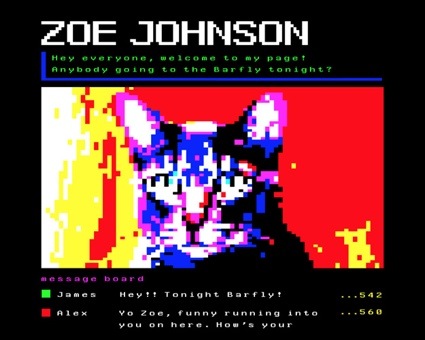 Social Teletext Network. Profile page of Zoe Johnson
Social Teletext Network. Profile page of Zoe Johnson
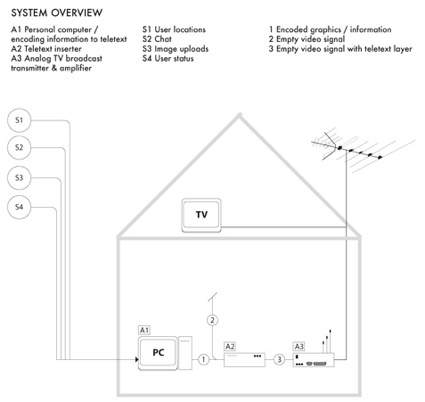 Social Teletext Network
Social Teletext Network
Is the Social Teletext Network installation at the show a working prototype? Which part of the communication would it replace exactly? I can’t believe it could replace all internet communication, it seems to be so rudimentary.
The Social Teletext Network in the show was showing a demo. But I have the hardware and the software ready to switch it on. The demo in the show was created with the help of the same software which is used in the real setup. Unfortunately it is highly illegal to broadcast your own TV signals, therefore I decided to show a demo in the show. I could apply for analogue (VHF) frequencies, but it is very expensive (too expensive for a student project).
It is not meant to replace the entire Internet. The technical limitations for this task are too high. The Social Teletext Network is capable to provide wireless information streaming, using the old obsolete teletext technology, which makes it harder to track or to monitor. I tried to port some comfort which we know from computer interaction to the Social Teletext Network. For example: You can zoom into specific regions on a map and visualise user locations and other information.
The Teletext specifications provide a very limited resolution and it can only display text and graphics programmed with single pixels. Overall, the strength is that you can send and receive information wireless and over a distance (5km and even more possible with the right hardware and a high antenna).
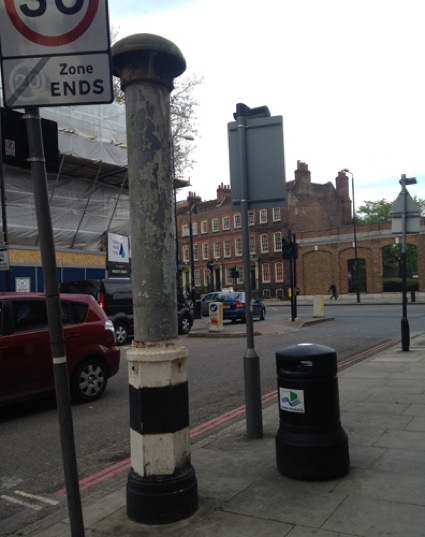 Sewer Cloud. Stench pipes provide access points to the sewerage system
Sewer Cloud. Stench pipes provide access points to the sewerage system
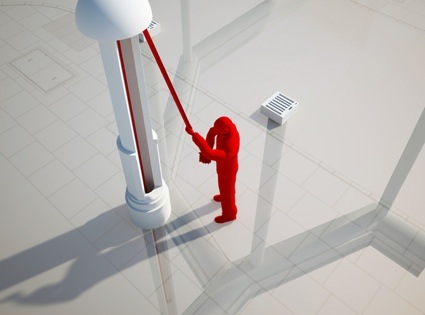 Sewer Cloud. Accessing the sewer system and obtaining algae
Sewer Cloud. Accessing the sewer system and obtaining algae
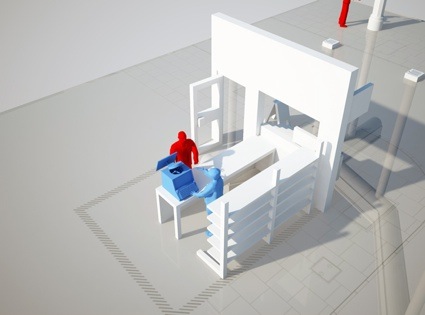 Sewer Cloud. Data extraction from and insertion into algae at the local corner shop
Sewer Cloud. Data extraction from and insertion into algae at the local corner shop
Algae circulation in London’s sewer system
Could you explain me with more details the process of the data insertion and extraction from algae? Because if i want to retrieve some data, how do i know which algae i should fish and where?
Text, images, video and any piece of digital data is written in binary code (110011110). These 1’s and 0’s are then encoded to the four base-pairs of DNA (Adenine, Cytosine, Thymine and Guanine). The new base-pair string will be synthesised to a complete DNA string and inserted into living organisms. To read data out of a DNA string the base-pairs would be decoded to 1’s and 0’s again and from that to human readable information.
In the beginning of each DNA string, there is an address block which indicates what kind of information is in each string. With this method you could know what you will find in a specific piece of algae.
As 1 gram of DNA can hold up to 700 terabytes (700.000 gigabytes), the amount of data what you can find in a single piece is very high.
If you would insert data into algae and hide the algae at a specific site, the chance that it stays there is high. It would reproduce itself and the following generations would go on a journey. But if the conditions are good, the origin would stay at the same spot and you could still find the same data even years after you have put it somewhere. So the idea is more, that you would know by locations where you can find specific information.
More infos here: Writing the Book in DNA and Test-tube data.
Thanks Philipp!
